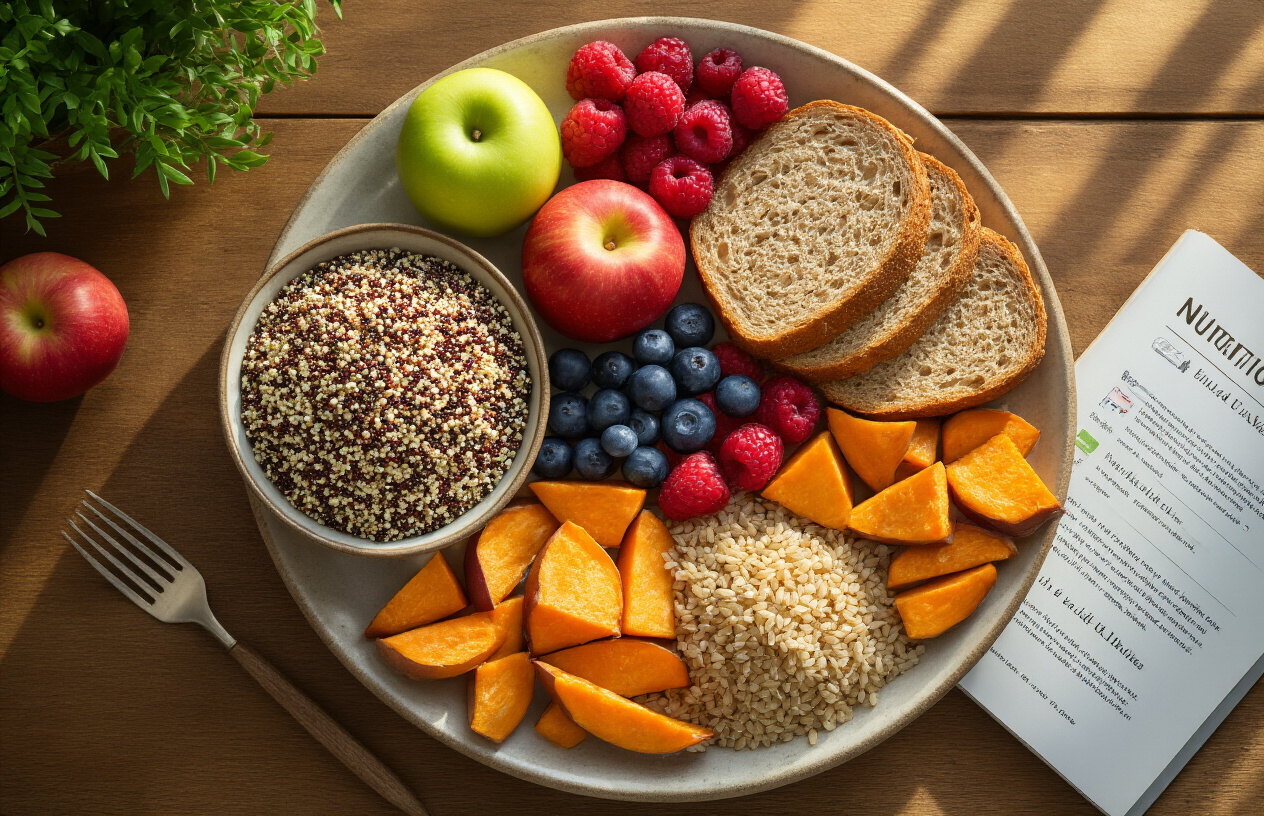Getting Your Carbs Right: How Much Your Body Actually Needs
Figuring out your carbohydrate daily requirements doesn’t have to feel like solving a math problem. This guide is for anyone who wants straight answers about carb intake—busy parents, fitness enthusiasts, people managing health conditions, or anyone tired of conflicting nutrition advice.
You’ll discover the official dietary guidelines that nutrition experts actually follow and how to adjust your carb needs based on your lifestyle, age, and activity level. We’ll also cover why the type of carbs you choose matters more than obsessing over exact numbers, plus simple timing strategies that can boost your energy throughout the day.
Understanding Your Body’s Carbohydrate Needs

How Your Body Uses Carbohydrates for Energy
Your body treats carbohydrates like premium fuel for a high-performance engine. When you eat carbs, your digestive system breaks them down into glucose, which enters your bloodstream and travels to cells throughout your body. This glucose becomes the primary energy source for your brain, muscles, and organs.
Your brain alone consumes about 20% of your daily glucose intake, burning through roughly 120 grams of carbs each day just to keep your thoughts flowing and reactions sharp. Without adequate carbohydrates, mental fog and fatigue quickly set in.
Muscles store glucose as glycogen, creating energy reserves for physical activity. During exercise, these glycogen stores fuel your movements, especially during high-intensity activities like sprinting or weight lifting. Your liver also maintains glycogen reserves, releasing glucose into your bloodstream when blood sugar levels drop between meals.
The process works like a sophisticated energy management system. When carbs are abundant, your body uses what it needs immediately and stores excess as glycogen. If glycogen stores fill up, remaining carbs convert to fat for long-term energy storage. When carbs run low, your body can produce glucose from proteins and fats, but this backup system is less efficient and can compromise muscle mass and metabolic function.
Factors That Influence Your Personal Requirements
Several key factors determine how many carbohydrates your body actually needs each day. Your activity level stands as the biggest game-changer. Sedentary individuals require significantly fewer carbs than athletes who train multiple hours daily. A desk worker might thrive on 45-65% of calories from carbs, while an endurance athlete could need 60-70% or more.
Body composition plays a major role too. Muscle tissue is metabolically active and stores glycogen, so people with more muscle mass typically need more carbohydrates to maintain their energy stores. Your metabolic rate also matters – some people naturally burn calories faster and require more fuel to maintain their energy levels.
Health conditions significantly impact carb requirements. People with diabetes must carefully manage their intake to control blood sugar levels. Those with metabolic syndrome might benefit from lower carb consumption, while individuals recovering from illness or injury often need additional carbs to support healing processes.
Your genetics influence how efficiently you process carbohydrates. Some people have genetic variations that affect insulin sensitivity, glucose metabolism, and carb tolerance. Environmental factors like stress, sleep quality, and climate also play roles. High stress increases cortisol production, which can affect blood sugar regulation and increase carb needs.
Current weight goals matter tremendously. People trying to lose weight might reduce carb intake to promote fat burning, while those building muscle or recovering from intense training need adequate carbs to support their goals.
The Role of Age and Gender in Carb Needs
Age brings significant changes to your carbohydrate requirements. Children and teenagers need proportionally more carbs than adults because they’re growing rapidly and tend to be more physically active. Young bodies also metabolize glucose more efficiently, allowing them to handle higher carb loads without negative effects.
As you age, several changes occur that affect carb needs. Muscle mass naturally declines after age 30, reducing your body’s glycogen storage capacity. Metabolism typically slows down, meaning you need fewer total calories and potentially fewer carbs. Insulin sensitivity often decreases with age, making blood sugar management more challenging and sometimes requiring carb intake adjustments.
Gender differences in carbohydrate needs are real but often overstated. Women generally require fewer total carbs than men simply because they typically have smaller body sizes and less muscle mass. However, women of reproductive age may need slightly more carbs during certain phases of their menstrual cycle due to hormonal fluctuations that affect metabolism and blood sugar regulation.
Men usually have higher baseline metabolic rates and more muscle mass, translating to higher overall carb requirements. They also tend to be more insulin sensitive on average, allowing for better carb tolerance.
Hormonal changes significantly impact carb needs for both genders. Women going through menopause often experience changes in insulin sensitivity and fat distribution that may warrant adjusting carb intake. Men with declining testosterone levels might also benefit from modified carb consumption patterns to support their changing metabolic profiles.
Official Dietary Guidelines for Carbohydrate Intake

Recommended Daily Allowance by Health Organizations
Major health organizations worldwide agree on the fundamental carbohydrate recommendations, though their approaches vary slightly. The Institute of Medicine sets the Recommended Daily Allowance (RDA) for carbohydrates at 130 grams per day for adults and children over one year old. This amount covers the glucose needs of the brain under normal circumstances.
The World Health Organization recommends that carbohydrates should make up 55-75% of total daily energy intake, while the American Heart Association suggests 45-65% of total calories. The Academy of Nutrition and Dietetics aligns with the 45-65% range, emphasizing that this percentage allows for adequate protein and fat intake while meeting energy needs.
These guidelines serve as baseline recommendations for healthy individuals. The 130-gram minimum represents the absolute lowest amount needed to prevent ketosis and maintain normal brain function, not necessarily the optimal amount for active individuals or those with higher energy demands.
Percentage of Total Calories from Carbohydrates
The 45-65% carbohydrate range translates differently based on individual calorie needs. For someone consuming 2,000 calories daily, this means 900-1,300 calories from carbohydrates, or 225-325 grams. A person eating 1,500 calories would need 169-244 grams of carbohydrates.
| Daily Calories | 45% Carbs (grams) | 65% Carbs (grams) |
|---|---|---|
| 1,500 | 169 | 244 |
| 2,000 | 225 | 325 |
| 2,500 | 281 | 406 |
| 3,000 | 338 | 488 |
The lower end of this range works well for sedentary individuals or those following moderate carbohydrate approaches, while the higher end supports active lifestyles and endurance activities. Athletes often consume carbohydrates at the upper end or even beyond this range during training periods.
Minimum Requirements for Brain Function
Your brain runs almost exclusively on glucose, consuming about 120 grams of glucose daily under normal conditions. This accounts for roughly 20% of your body’s total energy expenditure despite the brain representing only 2% of body weight. The 130-gram RDA provides a small buffer above this critical threshold.
During periods of carbohydrate restriction, the brain can adapt to use ketones for up to 70% of its energy needs, but this adaptation takes time and may not be optimal for everyone. Children’s developing brains have even higher glucose requirements relative to body size, making adequate carbohydrate intake particularly important for proper cognitive development.
The brain cannot store glucose like muscles can store glycogen, making it dependent on a steady supply from the bloodstream. This dependency explains why blood sugar crashes can cause immediate symptoms like confusion, irritability, and difficulty concentrating.
Upper Limits for Optimal Health
Unlike other macronutrients, carbohydrates don’t have an established upper intake level because excess carbohydrates are generally converted to fat rather than causing acute toxicity. However, practical upper limits exist based on digestive capacity and metabolic health considerations.
Most people can comfortably process 5-7 grams of carbohydrates per kilogram of body weight daily without digestive distress. For a 70-kilogram person, this equals 350-490 grams of carbohydrates. Endurance athletes may consume even higher amounts during heavy training periods.
The real concern with high carbohydrate intake relates to food quality and metabolic health rather than absolute amounts. Consuming excessive refined carbohydrates can lead to blood sugar spikes, increased triglycerides, and potential insulin resistance over time. The focus should be on staying within the recommended percentage range while prioritizing nutrient-dense carbohydrate sources that provide vitamins, minerals, and fiber alongside energy.
Adjusting Carb Requirements for Different Lifestyles

Sedentary Individuals and Office Workers
People who spend most of their day sitting at desks need fewer carbohydrates than their more active counterparts. Your muscles aren’t burning through glucose at the same rate when you’re answering emails or sitting in meetings all day. The sweet spot for sedentary adults typically falls between 225-325 grams of carbs daily for a 2,000-calorie diet.
Key considerations for desk-bound lifestyles:
- Focus on complex carbs that provide steady energy without crashes
- Space carbohydrate intake throughout the day to maintain stable blood sugar
- Choose fiber-rich options like oatmeal, quinoa, and whole grain bread
- Limit refined sugars and processed foods that can lead to afternoon energy slumps
Office workers should pay special attention to meal timing. A carb-heavy lunch can trigger that familiar 3 PM crash, making productivity plummet. Instead, balance your carbs with protein and healthy fats at each meal.
Active Adults and Weekend Warriors
Regular gym-goers, hikers, and recreational athletes need more fuel to power their workouts and recovery. Active adults typically require 325-450 grams of carbohydrates daily, with timing playing a bigger role than for sedentary individuals.
Pre-workout carb strategy:
- Eat 30-60 grams of easily digestible carbs 1-2 hours before exercise
- Choose foods like bananas, toast with honey, or energy bars
- Avoid high-fiber foods that might cause digestive issues
Post-workout recovery:
- Consume 15-25 grams of carbs within 30 minutes after exercise
- Pair with protein for optimal muscle recovery
- Chocolate milk, fruit smoothies, or Greek yogurt with berries work well
Weekend warriors who exercise intensely 2-3 times per week should increase carb intake on workout days while scaling back slightly on rest days. This approach helps fuel performance while preventing excess carb storage as fat.
Endurance Athletes and High-Performance Needs
Serious athletes pushing their bodies to the limit require significantly more carbohydrates than the average person. Endurance athletes often need 450-700 grams of carbs daily, sometimes even more during heavy training periods or competition seasons.
Training phase adjustments:
- Base training: 5-7 grams per kg of body weight
- High-intensity training: 7-10 grams per kg of body weight
- Competition day: Up to 12 grams per kg of body weight
| Training Intensity | Carbs per kg Body Weight | Example for 70kg Athlete |
|---|---|---|
| Light training | 3-5g | 210-350g daily |
| Moderate training | 5-7g | 350-490g daily |
| Heavy training | 7-12g | 490-840g daily |
Endurance athletes must master carb loading before big events, gradually increasing intake while reducing training volume. During long events lasting over 90 minutes, consuming 30-60 grams of carbs per hour helps maintain performance and prevent bonking.
Pregnant and Breastfeeding Women
Growing a baby and producing breast milk significantly increases carbohydrate needs. Pregnant women need an extra 175 grams of carbs daily during the second and third trimesters, while breastfeeding mothers require additional carbs to support milk production.
Pregnancy considerations:
- Total daily carbs should be around 175 grams minimum
- Focus on nutrient-dense carbs like sweet potatoes, whole grains, and fruits
- Avoid simple sugars that can contribute to gestational diabetes
- Spread intake evenly to help manage morning sickness and energy levels
Breastfeeding needs:
- Add 50-70 extra grams of carbs daily above pre-pregnancy levels
- Choose carbs rich in B vitamins and folate
- Stay consistent with timing to maintain steady milk supply
- Whole grain cereals, quinoa, and legumes provide excellent nutrition
Both pregnant and nursing women should prioritize food quality over quantity, choosing carbs that provide essential vitamins and minerals needed for fetal development and milk production.
Age-Specific Carbohydrate Recommendations

Growing Children and Adolescent Needs
Children and teenagers need more carbohydrates per kilogram of body weight than adults due to their rapid growth and high activity levels. Toddlers aged 1-3 years require about 130 grams of carbohydrates daily, while children aged 4-8 need approximately 130-200 grams. Preschoolers burn through carbs quickly because their brains are developing rapidly and require steady glucose supply.
During the teenage years, carbohydrate needs spike dramatically. Adolescents aged 9-18 should consume 45-65% of their total calories from carbohydrates, translating to 225-325 grams daily for most teens. Active teenage athletes may need even more – sometimes 400-500 grams per day to fuel their training and support normal growth patterns.
Growing bodies prioritize carbs for brain development, physical growth, and energy for play and sports. Missing adequate carbohydrate intake during these crucial years can impact cognitive development, mood regulation, and physical performance. Parents should focus on providing complex carbohydrates through whole grains, fruits, vegetables, and dairy products rather than relying on sugary snacks that cause energy crashes.
The timing matters too – spreading carbohydrate intake throughout the day helps maintain stable blood sugar levels and supports better concentration in school. Breakfast should include 30-40 grams of carbs, while lunch and dinner can provide 50-70 grams each, with healthy snacks filling the gaps.
Adult Maintenance Requirements
Adults typically need 225-325 grams of carbohydrates daily, representing 45-65% of total caloric intake. For someone consuming 2,000 calories per day, this means 900-1,300 calories should come from carbohydrates. However, these numbers aren’t set in stone – individual needs vary based on body size, activity level, and metabolic health.
Sedentary adults can function well on the lower end of this range, around 225-250 grams daily. Office workers and those with minimal physical activity don’t require as many carbs since their energy expenditure remains relatively stable throughout the day. Their bodies become efficient at using stored energy and don’t need constant carbohydrate replenishment.
Active adults need more carbohydrates to fuel their workouts and daily activities. Someone who exercises regularly should aim for 250-300 grams daily, while endurance athletes or those doing intense training might need 400+ grams. The key is matching carbohydrate intake to energy output – eating too few carbs when you’re active leads to fatigue, poor performance, and muscle breakdown.
| Activity Level | Daily Carbs (grams) | % of Total Calories |
|---|---|---|
| Sedentary | 225-250 | 45-50% |
| Moderately Active | 250-300 | 50-60% |
| Very Active/Athletic | 300-400+ | 55-65% |
Adults should prioritize nutrient-dense carbohydrates that provide vitamins, minerals, and fiber alongside energy. This includes whole grains, legumes, fruits, and vegetables rather than processed foods high in added sugars.
Senior Nutrition and Metabolic Changes
Older adults face unique challenges when it comes to carbohydrate needs. Metabolic rate naturally decreases with age, meaning seniors typically require fewer total calories and carbohydrates than younger adults. Most adults over 65 need around 180-230 grams of carbohydrates daily, representing about 45-55% of their total caloric intake.
Age-related changes affect how the body processes carbohydrates. Insulin sensitivity often decreases, making blood sugar management more challenging. Many seniors develop glucose intolerance or type 2 diabetes, requiring careful attention to carbohydrate timing and quality. Choosing low-glycemic carbs helps prevent dramatic blood sugar spikes.
Digestive changes also impact carbohydrate absorption. Reduced stomach acid production and slower gut motility mean seniors may struggle to digest certain carbs effectively. Simple sugars and refined grains can cause digestive discomfort, while high-fiber foods might need to be introduced gradually.
Despite lower calorie needs, seniors shouldn’t drastically cut carbohydrates. The brain still requires about 120 grams of glucose daily regardless of age. Severe carb restriction can lead to cognitive issues, mood changes, and decreased quality of life. Smart carb choices become even more important – focusing on nutrient-dense options that provide maximum nutritional value.
Seniors benefit from eating smaller, frequent meals containing 20-30 grams of carbohydrates each. This approach helps maintain steady blood sugar levels while accommodating decreased appetite and digestive capacity. Pairing carbs with protein and healthy fats further improves blood sugar stability and nutrient absorption.
Quality Over Quantity in Carbohydrate Selection

Complex Carbohydrates for Sustained Energy
Complex carbohydrates serve as your body’s premium fuel source, delivering steady energy that keeps you going throughout the day. These nutrient powerhouses include whole grains, legumes, starchy vegetables, and unprocessed cereals that provide a slow, controlled release of glucose into your bloodstream.
Unlike their simple counterparts, complex carbs contain long chains of sugar molecules that take time and energy to break down. This process prevents the blood sugar spikes and crashes that leave you feeling tired and hungry shortly after eating. When you choose oatmeal over sugary cereal or sweet potato over white bread, you’re giving your body fuel that burns slowly and steadily.
The fiber content in complex carbohydrates adds another layer of benefit. Fiber slows digestion even more, helping you feel satisfied longer while supporting healthy gut bacteria. Your digestive system works harder to process these foods, which actually burns more calories during digestion.
Top Complex Carbohydrate Sources:
- Quinoa and brown rice
- Beans, lentils, and chickpeas
- Sweet potatoes and winter squash
- Whole grain pasta and bread
- Oats and barley
Simple Carbs and When to Use Them
Simple carbohydrates aren’t always the villain they’re made out to be. These quick-digesting sugars have specific times when they actually serve your body well. The key lies in understanding when and how to use them strategically.
Your body absorbs simple carbs rapidly, causing blood glucose levels to rise quickly. This makes them perfect for immediate energy needs, particularly around exercise. Athletes often rely on simple carbs during long workouts or competitions because they provide instant fuel when glycogen stores run low.
Strategic Times for Simple Carbs:
- Pre-workout (15-30 minutes before): Banana or dates for quick energy
- During extended exercise: Sports drinks or energy gels for endurance activities
- Post-workout (within 30 minutes): Combined with protein to replenish glycogen stores
- When blood sugar drops: Natural sources like fruit can provide quick relief
Natural simple carbs from fruits come with vitamins, minerals, and fiber that processed sugars lack. A piece of fruit delivers simple sugars alongside nutrients that support overall health, while candy provides empty calories with no nutritional value.
Fiber Requirements Within Daily Carb Intake
Fiber plays a crucial role in your daily carbohydrate strategy, yet most people fall short of recommended intake levels. Adults should aim for 25-35 grams of fiber daily, with this amount naturally fitting within your total carbohydrate allowance.
Soluble fiber dissolves in water, forming a gel-like substance that helps lower cholesterol and stabilize blood sugar. You’ll find this type in oats, apples, beans, and citrus fruits. Insoluble fiber doesn’t dissolve in water but adds bulk to stool and helps food move through your digestive system. Whole grains, nuts, and vegetables provide this type.
Daily Fiber Targets by Food Group:
- Fruits: 6-8 grams from 2-3 servings
- Vegetables: 10-15 grams from 3-5 servings
- Whole grains: 6-10 grams from 3-4 servings
- Legumes: 8-15 grams from 1-2 servings
Increasing fiber intake gradually prevents digestive discomfort. Add 5 grams weekly until you reach your target, and drink plenty of water to help fiber do its job effectively.
Avoiding Refined and Processed Options
Refined carbohydrates strip away the good stuff your body needs while keeping the calories. During processing, manufacturers remove fiber, vitamins, minerals, and phytonutrients, leaving behind mostly starch and sugar that your body processes too quickly.
White flour, white rice, and processed cereals cause rapid blood sugar increases followed by crashes that trigger hunger and cravings. These foods also lack the satiety factor that comes from fiber and protein, making it easier to overeat.
Common Refined Carbs to Limit:
- White bread and regular pasta
- Sugary cereals and breakfast bars
- Cookies, cakes, and pastries
- Soda and sweetened beverages
- White rice and instant potatoes
Reading ingredient labels helps you identify processed options. Watch for terms like “enriched flour,” “high fructose corn syrup,” and added sugars appearing in the first few ingredients. Choose products where whole grains appear first on the ingredient list.
Making simple swaps transforms your carbohydrate quality without dramatically changing your eating habits. Replace white rice with quinoa, choose whole grain bread over white, and snack on nuts and fruit instead of processed snack foods. These changes improve nutrient density while maintaining the energy and satisfaction carbohydrates provide.
Timing Your Carbohydrate Intake for Maximum Benefit

Pre-Workout Fuel for Energy
Your body runs on carbohydrates during exercise, making pre-workout timing absolutely critical for peak performance. Eating carbs 30 minutes to 3 hours before your workout gives your muscles the glucose they need to power through challenging sessions. The closer you eat to your workout, the simpler the carbs should be – think a banana or a small energy bar about 30-60 minutes beforehand.
For longer workouts lasting over 90 minutes, you’ll want to fuel up 2-3 hours prior with complex carbohydrates like oatmeal, whole grain toast, or quinoa. These provide sustained energy release without causing digestive discomfort mid-workout. Quick-digesting options work better for shorter sessions – dried fruit, crackers, or even a sports drink can give you that immediate energy boost.
Your individual tolerance matters here. Some people can handle a full meal two hours before exercise, while others need to stick to lighter options. Experiment during training to find what works best for your stomach and energy levels.
Post-Exercise Recovery and Muscle Replenishment
The 30-60 minutes after your workout represents a golden window for carbohydrate replenishment. Your muscles are primed to absorb glucose at their highest rate, making this the perfect time to refuel your glycogen stores. Skip this window, and your recovery takes longer.
Aim for 0.5-1.2 grams of carbs per kilogram of body weight within this timeframe. A 150-pound person needs roughly 34-82 grams of carbohydrates – that’s equivalent to a large banana with a cup of chocolate milk or a bagel with honey. Fast-absorbing carbs work best here: white rice, potatoes, dates, or sports drinks all fit the bill.
Pairing carbs with protein creates an even more powerful recovery combination. The classic chocolate milk delivers both macronutrients in ideal ratios, but you could also choose Greek yogurt with berries or a turkey sandwich on white bread. Your muscles will thank you with faster recovery and better adaptation to training.
Spreading Intake Throughout the Day
Rather than loading up on carbs in one or two massive meals, distributing them evenly throughout your day keeps your energy levels stable and supports better metabolic health. This approach prevents the blood sugar rollercoaster that leaves you feeling sluggish between meals.
Start your morning with complex carbs to kickstart your metabolism and brain function. Whole grain cereals, overnight oats, or whole wheat toast provide sustained energy for your morning activities. Mid-morning and afternoon snacks should include moderate amounts of carbohydrates – an apple with nuts or whole grain crackers keep you steady without causing energy crashes.
Your largest carb portions should align with your most active periods. If you exercise in the evening, save more carbs for lunch and dinner. Morning exercisers benefit from heavier carb intake earlier in the day. This strategic distribution ensures your body has fuel when it needs it most while supporting overnight recovery and repair processes.
Evening carbs aren’t the enemy many people think they are. Your body continues burning calories and repairing tissues overnight, and moderate carb intake with dinner can actually improve sleep quality and morning energy levels.

Your body needs carbs to function properly, and the general guideline of 45-65% of daily calories from carbs works for most people. But your personal needs might be different based on how active you are, your age, and your health goals. Athletes need more fuel for their workouts, while older adults might benefit from slightly fewer carbs and more protein.
The type of carbs you choose matters just as much as the amount. Focus on whole grains, fruits, and vegetables instead of processed foods and sugary snacks. These nutrient-dense options give you steady energy and keep you feeling full longer. Pay attention to when you eat carbs too – having them before workouts gives you energy, while eating them after exercise helps your muscles recover. Start tracking your carb intake for a week to see how different amounts and types affect your energy levels, then adjust from there.














